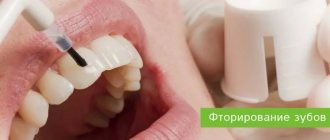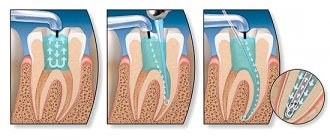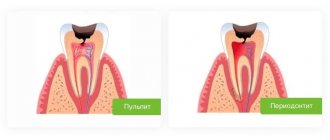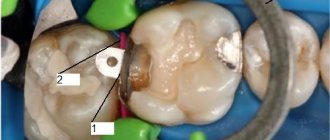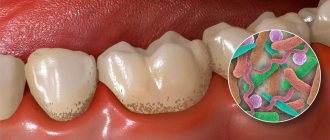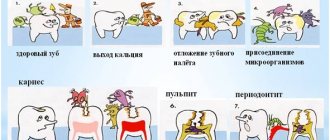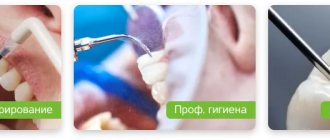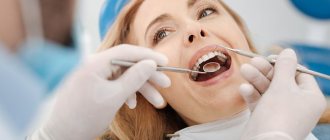Causes Types of prevention Hygiene Treatment in the stain stage How to avoid?
Caries is damage to hard dental tissues with the formation of cavity defects. First, the enamel is destroyed, then areas of dentin, pulp, periosteum and bone. It is the most common dental disease in the world and the leading cause of tooth loss. Comprehensive prevention of dental caries increases the resistance of the enamel layer to various cariogenic factors and prevents destruction of tooth structures.
Stopping the development of caries
It is advisable to stop the development of caries at the earliest possible stage: in this case, the disease will be much easier to treat.
At the initial stage, caries looks like a small spot. At this stage of development, it can be coated with a special gel that can restore damaged enamel. If you see a doctor on time, you may be able to do without the preparation procedure, which is, of course, completely painless.
If you start the development of caries, you will have to resort to drilling, and if the pulp is affected, this can add additional painful sensations.
In addition, ignoring caries is fraught with:
- destruction of the affected tooth and, as a result, expensive installation of an implant;
- indigestion, since the affected teeth cannot fully cope with the chewing function;
- aesthetic inconveniences.
Which toothbrush is better
Electric toothbrushes are many times more expensive than regular ones. But it does seem to make sense in terms of plaque and gingivitis control.
Researchers compared the teeth of adults and children who used electric and regular toothbrushes. Within a month, it turned out that among representatives of the first group, plaque formation decreased by 11%, and after three months - by 21%. After a month of using electric toothbrushes, the incidence of gingivitis decreased by 6%, and after 3 months - by 11%.
Models with a rotating head cope best with plaque.
Prevention of caries: local methods
These methods of preventing caries include:
- Remineralization is a procedure during which tooth enamel is saturated with fluoride and calcium, which has a positive effect on its strength. In addition, fluoride prophylaxis increases the resistance of enamel to microorganisms that provoke the development of caries.
When acidity drops below pH5, the concentration of calcium and a number of other elements in tooth enamel begins to rapidly decrease. It is at this moment that the greatest activity of cariogenic organisms is observed. After covering the tooth surface with fluoride varnish, fluorine begins to penetrate into the enamel, which, together with calcium, does not allow it to dissolve even in conditions of high acidity.
Remineralization can be:
- Homemade, which consists of the most ordinary thorough brushing of teeth with toothpastes containing fluoride. There are pastes with more effective amino fluoride (they have a higher price and a faster penetration rate of fluoride into the enamel), as well as with sodium monofluorophosphate (they are a budget option). For a more professional fluoride prophylactic course, in addition to toothpastes and rinses, you will need remineralizing gels, which need to be used every 3-4 months, which does not replace brushing your teeth. If you follow these rules throughout your life, there's a good chance you'll never have to treat tooth decay.
- Professional , for which you cannot do without visiting a doctor. Its main advantage is better efficiency due to the use of drugs characterized by a higher concentration of active substances. During the procedure, the teeth are coated with a transparent fluoride-containing varnish, which actively penetrates the enamel over the course of several hours. Gradually the film dissolves.
WHO recommends fluoride prophylaxis in two ways: using fluoride pastes at home and periodically resorting to the use of professional preparations that modern dentistry can offer.
- Proper oral hygiene , which is both a simple and very important step in caries prevention, prevents the appearance of carious areas.
A considerable part of people believe that their oral hygiene is absolutely fine. However, if this were true, the disease would not be so common.
Clinical researches
ASEPTA toothpastes are clinically proven effective. For example, clinical studies have proven that regular use of professional toothpaste ASEPTA REMINERALIZATION improved the condition of the enamel by 64% and reduced tooth sensitivity by 66% after just 4 weeks.
In addition, clinical studies have proven that regular use of preventive toothpaste ASEPTA ACTIVE for a month can reduce bleeding gums by 60%, improve the overall condition of the oral cavity by 44% and reduce inflammation by 33%.
Sources:
- Report on determining/confirming the preventive properties of toothpaste “ASEPTA PLUS” GENTLE WHITENING” Author: doctor-researcher A.A. Leontyev, head Department of Preventive Dentistry, Doctor of Medical Sciences, Professor S.B. Ulitovsky First St. Petersburg State Medical University named after. acad. I.P. Pavlova, Department of Preventive Dentistry
- Clinical and laboratory assessment of the influence of domestic therapeutic and prophylactic toothpaste based on plant extracts on the condition of the oral cavity in patients with simple marginal gingivitis. Doctor of Medical Sciences, Professor Elovikova T.M.1, Candidate of Chemical Sciences, Associate Professor Ermishina E.Yu. 2, Doctor of Technical Sciences Associate Professor Belokonova N.A. 2 Department of Therapeutic Dentistry USMU1, Department of General Chemistry USMU2
- Report on the determination/confirmation of the preventive properties of personal oral hygiene products “ASEPTA PLUS” Remineralization doctor-researcher A.A. Leontyev, head Department of Preventive Dentistry, Doctor of Medical Sciences, Professor S.B. Ulitovsky First St. Petersburg State Medical University named after. acad. I.P. Pavlova, Department of Preventive Dentistry
- Clinical studies of antisensitive toothpaste “Asepta Sensitive” (A.A. Leontyev, O.V. Kalinina, S.B. Ulitovsky) A.A. LEONTIEV, dentist O.V. KALININA, dentist S.B. ULITOVSKY, Doctor of Medical Sciences, Prof. Department of Therapeutic Dentistry, St. Petersburg State Medical University named after. acad. I.P. Pavlova
- The role of anti-inflammatory rinse in the treatment of periodontal diseases (L.Yu. Orekhova, A.A. Leontyev, S.B. Ulitovsky) L.Yu. OREKHOVA, Doctor of Medical Sciences, Prof., Head of Department; A.A. LEONTIEV, dentist; S.B. ULITOVSKY, Doctor of Medical Sciences, Prof. Department of Therapeutic Dentistry of St. Petersburg State Medical University named after. acad. I. P. Pavlova
- Report on determining/confirming the preventive properties of toothpaste “ASEPTA PLUS” COFFEE and TOBACCO Author: doctor-researcher A.A. Leontyev, head Department of Preventive Dentistry, Doctor of Medical Sciences, Professor S.B. Ulitovsky. First St. Petersburg State Medical University named after. acad. I.P. Pavlova, Department of Preventive Dentistry
- Report on determining/confirming the preventive properties of commercially produced personal oral hygiene products: Asepta toothpaste used in combination with Asepta mouthwash and Asepta gum balm Head. Department of PFS Doctor of Medical Sciences Professor S.B. Ulitovsky St. Petersburg State Medical University named after Academician I.P. Pavlova. Faculty of Dentistry. Department of Preventive Dentistry.
How to prevent tooth decay
- Regular brushing of teeth (preferably after every meal). Moreover, you should brush your teeth not an hour or two, but within 5 minutes after eating. It has been proven that food debris and pathogens cause maximum harm to teeth in the first 40 minutes. Is it necessary to brush your teeth after every meal, that is, even after a light snack or tea with candy? Yes, it is necessary, and you need to clearly understand this for yourself. Therefore, you should not overuse snacks during the day.
- Dental floss - This is not an additional tool for cleaning the oral cavity, but is as basic as a toothbrush. Floss must be used in the same way after each meal. For a person who has never used floss before, it may be difficult to understand how to use it - a dentist can help with this. The task of dental floss is to remove food debris between the teeth (caries, no less rarely, develops not only in the tooth cavity, but also between two adjacent teeth).
- What to do if brushing your teeth is problematic (for example, in a cafe or outdoors)? You should always have dental floss or, as a last resort, chewing gum with you. A package of thread does not take up much space, and you can use it by going to the toilet (if we are talking about a room) or stepping aside. Many people are embarrassed to behave this way, as a result, subsequently they will not always have simple and cheap treatment for caries. Embarrassment is inappropriate here: there is nothing shameful in getting up and going to the restroom for a couple of minutes. It’s much better to breathe in freshness afterwards, rather than “delight” those around you with the aromas of a recently eaten lunch.
- Food debris often accumulates under dentures and braces.. People who have crowns in their mouths can be advised to use an irrigator - a device that delivers a stream of water through a special nozzle, saturated with air bubbles and washing away food debris. The device is especially effective for gingivitis and periodontitis, when pockets form where a large number of microbes accumulate. Periodontal pockets are very difficult to clean with a brush or floss, but an irrigator can cope with this task perfectly. The device is also recommended for pregnant women, who often suffer from gingivitis.
In addition to brushing and flossing, the following can help prevent tooth decay:
- strengthening the immune system. A weakened body is not able to fully resist the effects of bacteria. To minimize the risk of developing caries, subject to good hygiene, you need to take care of your immunity through the use of vitamins and hardening;
- properly formulated diet. First of all, you need to reduce the consumption of simple carbohydrates, and also increase the amount of foods containing fluoride and calcium in the menu. We must not forget about regular consumption of hard fruits and vegetables, which cleanse teeth of plaque.
What else do you need to know?
- To maintain healthy teeth and gums, it is important to use a brush of medium hardness; the bristles should not scratch the enamel and mucous membrane or cause discomfort. It must be changed at least every 2 months, since pathogenic microorganisms accumulate on the bristles. You also need to replace the brush if it has lost its original shape.
- When using a toothpaste containing fluoride, you must not only brush your teeth for 2-3 minutes, but also not rinse your mouth for the same amount of time. During this period, the active components will penetrate the enamel, which will increase the effectiveness of remineralization.
- When choosing a toothpaste with fluoride, it is better to give preference to more expensive options, since they contain sodium aminofluorides. These substances are more effective than sodium monofluorophosphate, which is present in budget toothpastes. Saving in this case is impractical.
- Do not neglect mouth rinses. They contain sodium fluorides and aminofluorides, antiseptic and antibacterial components that prevent plaque formation and inhibit the growth and reproduction of cariogenic microbes. But you should also not overuse mouthwashes, since antiseptics can disrupt the composition of the microflora of the oral cavity, resulting in an unpleasant odor.
Remember that caries prevention will be effective only with an integrated approach and regular visits to the dentist. It is better to make sure once again that your teeth are healthy than to treat the consequences of a negligent attitude towards yourself.
| Author of the article: | Gasparyan Eliza Arturovna |
| Speciality: | Dentist-therapist, dentist-endodontist |
| Experience: | 10 years |
Make an appointment
Caries: general methods of prevention
- The main reason for the development of caries is carbohydrates consumed during meals (simple carbohydrates, i.e. sugars, are especially harmful). As a rule, a person consumes these elements between main meals (for example, drinking tea with sugar or confectionery). If you give up snacking, you will reduce the risk of developing caries.
- The use of vitamins that prevent the development of caries. In Russia, this method is not very common, although the anti-caries effect of vitamins B6 and B1 has long been proven. However, no pill, even taken on a regular basis, can prevent tooth decay if oral hygiene suffers.
- Fluoridation. This method of caries prevention helps strengthen the strength of enamel, increase its resistance to acid, and also get rid of the pain reaction to eating too hot or cold food. In simple fluoridation, fluoride gel is applied to the tooth. Deep fluoridation involves sealing the enamel. This is a longer process in which the teeth are first dried, then deep fluoride is applied to them, followed by drying again and the use of copper-calcium hydroxide.
- Infiltration. With this method of preventing dental caries, the stain is lubricated with an etching composition, then a drug that seals the pores is applied to the cleaned surface of the tooth. Infiltration allows you to stop the development of caries and the increase in the size of the carious spot, since the acid released by bacteria is not able to penetrate into the enamel. The method is absolutely painless, therefore it is recommended, including for children. The only condition for successful completion of the procedure is sitting still for 20 minutes, so infiltration may not be suitable for restless children.
- Ozone therapy.
- Laser therapy.
If a hole has already appeared in the tooth, then the above prevention options will not help: you will have to resort to surgical intervention.
The role of nutrition in preventing dental caries
One of the effective measures to combat caries is the correct approach to nutrition. The tissues of the oral cavity are sensitive to the lack of certain food components. In particular, a lack of protein in the diet prevents the accumulation of calcium and disrupts the structure and strength of enamel. At the same time, foods that are too fatty increase the permeability of the enamel, which increases the likelihood of the formation of carious lesions.
An excess of refined carbohydrates (sweets, flour products, sugar) in the diet not only reduces the resistance of teeth to the development of caries, but also weakens the immune defense, which is also a risk factor.
To prevent caries, it is important to adhere to the following dietary recommendations:
- A sufficient amount of protein must be present in the daily diet;
- eat foods containing vitamins C, D and group B;
- be sure to eat foods rich in calcium and phosphorus (milk, cheese, eggs, fish, broccoli, legumes), as well as fluoride-containing foods (sea fish, Georgian tea);
- it is necessary to limit the consumption of foods rich in “fast” carbohydrates, eat as little sweets, cakes and refined sugar as possible;
- Avoid sticky products: they can remain on the surface of tooth enamel for up to an hour, contributing to its demineralization for a long time.
The nature of your diet directly affects the condition of your teeth. A rational, fortified, balanced diet is an effective method of non-drug prevention of caries.
Dental caries in children
In children, identifying caries is quite simple: first, white or brown spots appear on the teeth, then the teeth begin to react to hot or cold food, and bad breath may appear. All these symptoms indicate the rapid development of the disease. If action is not taken in time, the infection can spread to several teeth at once.
Causes of caries development in children:
- The main cause of childhood caries is poor oral hygiene. The task of parents is to choose the right toothbrush for their child and teach him how to brush his teeth. Many young children are afraid of this harmless procedure, so we can recommend trying to present brushing as a game. It is necessary to accustom a child to brush independently starting from the age of 3 (before this moment, parents should brush the child’s gums and teeth).
- The infection can be transmitted from an adult to a child. As a rule, this happens if you eat with a child with the same spoon or kiss him on the lips, which is often abused by adults who are unable to cope with an overabundance of feelings.
- Genetic characteristics associated with abnormal maternal lifestyle during pregnancy. Teeth form during the first trimester, so if a woman smokes or drinks alcohol, this can affect the baby's dental development.
- Early caries, which appears in children before the age of 2 years, can be caused by poor mineralization of baby teeth.
- Various chronic diseases can also cause cavities.
- In infants, bottle tooth decay often occurs when the child eats food before bed. After eating, food residues remain on the teeth, and parents, instead of brushing the child’s teeth, put him to bed.
conclusions
There is a clear algorithm, following which, with a high degree of probability, you will never encounter the problem of caries.
- Regular removal of plaque and tartar is the key to healthy teeth . Good oral hygiene is the best cure for any disease related to teeth and gums.
- Proper diet . It is necessary to compose the daily menu in such a way that it contains as little flour and sweets as possible (food consisting mainly of easily digestible carbohydrates). It is also worth giving up sugary drinks (soda contains an extremely large amount of sugar). By avoiding sugary snacks, you can minimize your risk of tooth decay.
- Measures that increase the resistance of enamel to acids produced by pathogenic microorganisms should be carried out several times a year.
Why do you need interdental brushes?
In 2015, a review of seven studies was published in which 354 patients brushed their teeth in three ways:
- only with a brush;
- brush and floss;
- brush and brushes.
Only once did scientists note that additional cleaning with a brush had advantages over brushing. But the evidence cannot be considered rigorous, since we are talking about a superficial study: the effect has not been analyzed in the long term. The same goes for comparing brushes and dental floss.
There is not enough data yet to draw conclusions about the benefits of brushes for interdental spaces.
